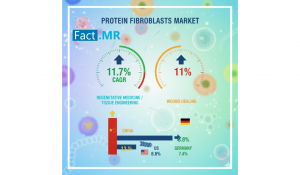Protein Fibroblasts Market Is Anticipated to Reach USD 345.1 Million by 2035
Protein Fibroblasts Market to hit USD 345.1M by 2035, growing at 10.6% CAGR, driven by biotech innovation & regenerative medicine demand.
ROCKVILLE PIKE, MD, UNITED STATES, September 25, 2025 /EINPresswire.com/ -- Protein Fibroblasts Market, segmented by product type (Recombinant Proteins from Fibroblasts; Purified Fibroblast-Derived Proteins; Modified or Engineered Fibroblast Proteins; Protein Complexes or Matrices), biological source / origin, application, end-user, and region, is witnessing remarkable growth driven by innovation in regenerative medicine, cosmetic science, and laboratory research. According to a new Fact.MR report, recent developments among major players and competitor strategies reveal an increasingly dynamic competitive landscape.Global Market Outlook 2025–2035: Forecast & Growth Drivers
The global protein fibroblasts market is expected to reach USD 345.1 million by 2035, up from USD 126.0 million in 2025. Over the forecast period of 2025 to 2035, the industry is projected to expand at a compound annual growth rate (CAGR) of 10.6%.
This growth is being powered by surging demand in wound healing, tissue engineering, and regenerative medicine. Chronic wounds, burns, and skin-aging concerns are contributing significantly to end-user interest, while advances in recombinant protein technologies, 3D bioprinting, and stem cell-derived fibroblast methods are opening up new product possibilities. Regulatory support, rising R&D investment, and the expanding role of biotech in health systems globally are reinforcing market momentum.
Full Market Report available for delivery. For purchase or customization, please request here -
https://www.factmr.com/connectus/sample?flag=S&rep_id=11049
Product Type & Biological Source: Who’s Leading
Among product types, recombinant proteins from fibroblasts currently hold the largest market share (about 27.3% in 2025) and are expected to maintain leadership through 2035. These are preferred for their scalability, consistency, and suitability for clinical, cosmetic, and therapeutic uses.
Regarding biological source/origin, human fibroblast cultures, animal fibroblasts, engineered synthetic analogues, and stem-cell derived fibroblasts are all in play. Human and stem cell derived fibroblasts are seeing increasing investment due to their closer relevance in therapeutic/ag-bio contexts and better biocompatibility.
Applications & End-Users: Expanding Horizons
Key applications include regenerative medicine / tissue engineering, wound healing, cosmetics / anti-aging / skin care, and research & diagnostics. Notably, regenerative medicine and tissue engineering are projected to grow at especially high rates (around 11.7%), while wound healing also records substantial growth (about 11.0%) over the forecast period.
End-users span hospitals/clinics, cosmetic/cosmeceutical companies, biotech/pharma firms, and academic/research institutions. Hospitals and clinics are rapidly adopting clinical-grade fibroblast products for therapeutic uses, and cosmetic firms continue to push demand for anti-aging and skin rejuvenation formulations. Research institutions underpin advancement by developing novel scaffolds, matrices or engineering fibroblast proteins for diagnostics and disease modeling.
For more on their methodology and market coverage, visit - https://www.factmr.com/about-company
Regional Trends: Leaders & Fastest-Growing Markets
North America currently leads, with strong biotechnology infrastructure, substantial R&D investment, and regulatory frameworks that support clinical applications. Europe follows, with Germany being a standout country due to its established pharma and life sciences sector. Asia Pacific, particularly China, is the fastest growing region (projected CAGR ~13.9%), driven by government incentives, increasing healthcare spending, and growing biotech capacity.
Challenges & Restraints
Despite its promising prospects, the market faces several headwinds: high production and processing costs limit participation by smaller players; issues of cell viability, reproducibility, and long-term stability complicate therapeutic applications; and regulatory convergence and standardization of quality remain inconsistent across geographies. Ethical and supply-chain hurdles, along with concerns over consistent funding for biotech research, also pose risks.
Competitive Analysis: Key Players & Recent Strategic Moves
Major companies currently shaping the protein fibroblasts market include Thermo Fisher Scientific, Lonza, Merck / MilliporeSigma, Bio-Techne / R&D Systems, PeproTech (via Thermo Fisher), PromoCell, and Rousselot.
Some of the recent developments:
In October 2024, Merck entered a licensing and collaboration agreement worth USD 1.9 billion with Mestag Therapeutics focused on fibroblast-based therapies to treat inflammatory diseases. This underscores Merck’s increasing commitment to regenerative medicine within its pipeline.
Fact.MR
In July 2024, FibroBiologics partnered with the University of Houston under the Technology Bridge innovation system. The goal is to accelerate development of fibroblast-based therapeutics targeting chronic diseases using academic-industry collaboration.
Other competitive strategies involve:
Expanding product lines into clinical-grade or customized fibroblast proteins and matrices.
Enhancing manufacturing scalability through improved bioreactor systems and automation.
Leveraging 3D bioprinting, synthetic analogues, stem cell-derived fibroblasts to diversify offerings.
Strengthening distribution networks, especially in Asia-Pacific, and collaborating with universities or research institutions for R&D and validation.
Conclusion
With the market’s value expected to climb from USD 126.0 million in 2025 to USD 345.1 million by 2035, growing at a CAGR of 10.6%, the Protein Fibroblasts sector is entering a phase of rapid ascent. Companies that innovate in product types (especially recombinant and engineered fibroblast proteins), harness advanced sources (human, stem cell, synthetic analogues), and navigate regulatory and cost challenges effectively are poised to lead the market. Regional expansion—especially in China and parts of Asia-Pacific—combined with strategic partnerships and technological breakthroughs will likely define the next wave of competitive advantage.
Check out More Related Studies Published by Fact.MR:
Recombinant Protein Market: https://www.factmr.com/report/186/recombinant-protein-market
Rice Protein Market : https://www.factmr.com/report/520/rice-protein-market
Editor’s Note:
This release is based exclusively on verified and factual market content derived from industry analysis by FactMR. No AI-generated statistics or speculative data have been introduced. This story is designed to support manufacturers, healthcare providers, and wellness brands in recognizing the Protein Fibroblasts industry as a major growth and innovation sector for the coming decade.
S. N. Jha
Fact.MR
+1 628-251-1583
email us here
Legal Disclaimer:
EIN Presswire provides this news content "as is" without warranty of any kind. We do not accept any responsibility or liability for the accuracy, content, images, videos, licenses, completeness, legality, or reliability of the information contained in this article. If you have any complaints or copyright issues related to this article, kindly contact the author above.

